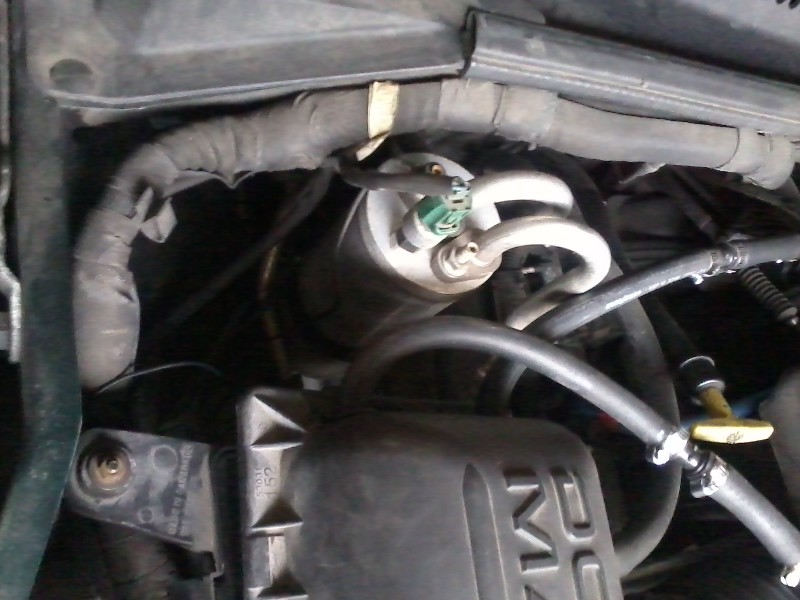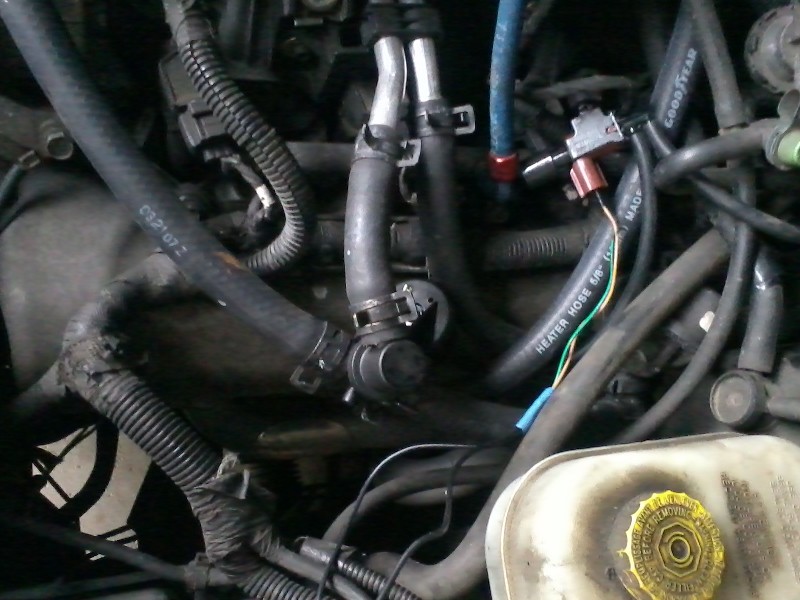 05-12-2012, 03:14 AM
05-12-2012, 03:14 AM
|
#21 (permalink)
|
|
MPGuino Supporter
Join Date: Oct 2010
Location: Hungary
Posts: 1,808
iNXS - '10 Opel Zafira 111 Anniversary Suzi - '02 Suzuki Swift GL
Thanks: 831
Thanked 710 Times in 458 Posts
|
Quote:
Originally Posted by Christ

Looking forward to results.
|
Okay, the results are in...
Distance travelled: 58.7 miles (94.5 km)
Yesterday:
Outside temperature: 58 F (14.4 C)
Intake temperature: (not recorded)
Fuel consumed: 3.18 gallons (12.02 L)
FE: 18.5 MPG (12.7 L/100km)
Today:
Outside temperature: 55 F (12.8 C)
Intake temperature: 98 F (36.7 C)
Delta T: 43 F (23.9 C)
Fuel consumed: 3.04 gallons (11.49 L)
FE: 19.3 MPG (12.2 L/100km)
So, about a 4.4% improvement in fuel economy.
Keep in mind that this is not a strict A-B-A test. For one, the intake heater was not connected to the cooling system last night. For two, there were two stretches of highway that were under late-night construction last night, causing me to slow down for the better part of a mile.
Tomorrow, I am going to block off the uncovered parts of the airbox roof (where the intake heater is mounted), so as to force all of the intake air through the intake heater. Hopefully, this will be able to cause intake temperature to reach 130 F during the nighttime (return) commute. In the slightly longer term, I am going to find a more efficient transmission cooler (possibly one of them plate-and-fin types) and use that, instead of the tube-and-fin cooler I currently have installed.
|
|
|

|
 Today Today
|
|
|
|
 Other popular topics in this forum...
Other popular topics in this forum...
|
|
|
|
 05-12-2012, 09:12 AM
05-12-2012, 09:12 AM
|
#22 (permalink)
|
|
EcoModding Apprentice
Join Date: Jan 2012
Location: Oakton, VA
Posts: 189
Thanks: 1
Thanked 24 Times in 19 Posts
|
Quote:
Originally Posted by Ford Man

Warm air is less dense and has less oxygen molecules therefore less oxygen in the exhaust stream for the 02 sensor to detect and the IAT sensor sends a warmer temperature reading to the ECU, which fools the ECU into thinking the outdoor temperature is hotter than it actually is and leans out the mixture. All cars run richer when cold air is being introduced into the engine. Many have found that warmer IAT's increase their mileage.
|
No. The mixture stays at 14.7 (or however close your factory ECU can hold it to this number). It takes a mass X of air to make Y power. The warmer the air, the higher the volume. The higher the volume the wider you need to open the throttle. Higher throttle position = less pumping losses. |
|
|

|
|
The Following 2 Users Say Thank You to ProDarwin For This Useful Post:
|
|
 05-12-2012, 09:23 AM
05-12-2012, 09:23 AM
|
#23 (permalink)
|
|
EcoModding Apprentice
Join Date: Jan 2011
Location: Australia
Posts: 179
Thanks: 9
Thanked 16 Times in 13 Posts
|
So the throttle plate is the 'largest' restriction?
__________________

|
|
|

|
 05-12-2012, 11:55 PM
05-12-2012, 11:55 PM
|
#24 (permalink)
|
|
Master EcoModder
Join Date: Dec 2011
Location: Boise Idaho
Posts: 842
Thanks: 39
Thanked 89 Times in 69 Posts
|
Quote:
Originally Posted by toc

Ehh??
CAI or WAI? Which one!
(The age old topic that never gets any solid data for or against).
|
which means it is all mouse nuts.
(too small to matter unless you are really into examining mouse nuts). |
|
|

|
 05-12-2012, 11:57 PM
05-12-2012, 11:57 PM
|
#25 (permalink)
|
|
Master EcoModder
Join Date: Dec 2011
Location: Boise Idaho
Posts: 842
Thanks: 39
Thanked 89 Times in 69 Posts
|
Quote:
Originally Posted by t vago

Okay, the results are in...
Distance travelled: 58.7 miles (94.5 km)
Yesterday:
Outside temperature: 58 F (14.4 C)
Intake temperature: (not recorded)
Fuel consumed: 3.18 gallons (12.02 L)
FE: 18.5 MPG (12.7 L/100km)
Today:
Outside temperature: 55 F (12.8 C)
Intake temperature: 98 F (36.7 C)
Delta T: 43 F (23.9 C)
Fuel consumed: 3.04 gallons (11.49 L)
FE: 19.3 MPG (12.2 L/100km)
So, about a 4.4% improvement in fuel economy.
.
|
statistically, this is about as valid as the results when measuring fuel magnets.
one test. not aba, and you don't even know the temperatures involved. |
|
|

|
 05-13-2012, 01:57 AM
05-13-2012, 01:57 AM
|
#26 (permalink)
|
|
MPGuino Supporter
Join Date: Oct 2010
Location: Hungary
Posts: 1,808
iNXS - '10 Opel Zafira 111 Anniversary Suzi - '02 Suzuki Swift GL
Thanks: 831
Thanked 710 Times in 458 Posts
|
Quote:
Originally Posted by toc

So the throttle plate is the 'largest' restriction?
|
Pretty much, yah. The intake poppet valves are a secondary restriction, but while the engine is heavily throttled, their restrictions are quite small as compared to the throttle plate. |
|
|

|
 05-13-2012, 02:31 AM
05-13-2012, 02:31 AM
|
#27 (permalink)
|
|
MPGuino Supporter
Join Date: Oct 2010
Location: Hungary
Posts: 1,808
iNXS - '10 Opel Zafira 111 Anniversary Suzi - '02 Suzuki Swift GL
Thanks: 831
Thanked 710 Times in 458 Posts
|
Drove the family up to Niagara Falls, Ontario (!). Along the way, gathered a few tank fills of data. Again, not strictly A-B-A, but the results are nonetheless telling.
May 11 - 363.8 miles - 19.113 gallons - 55.4 MPH average speed - 19.0 MPG (12.360 L/100km)
May 12 - 410.4 miles - 20.517 gallons - 57.0 MPH average speed - 20.0 MPG (11.759 L/100km)
That's a 4.9% increase.
Unfortunately, I did not have the time to install the blocking plates that I had wanted to make.
The intake heater, as installed, appears to give a reliable 45 F delta T between the outside air temperature (measured by the overhead display) and the intake air temperature (measured by ScanGauge II), when the truck is moving level at 72 MPH. Inclines and changes in vehicle speed change this delta T.
|
|
|

|
 05-13-2012, 09:04 AM
05-13-2012, 09:04 AM
|
#28 (permalink)
|
|
Master EcoModder
Join Date: Oct 2011
Location: ellington, ct
Posts: 831
Thanks: 44
Thanked 104 Times in 80 Posts
|
Quote:
Originally Posted by drmiller100

ummmmm,,,,, well, no.
it takes a certain amount of oxygen molecules to make a certain amount of power. If the molecules are warmer, they take up more space, so you have to give more throttle position to get the same amount of power.
But when done, it still takes the same number of molecules to make a certain amount of power.
If the molecules were colder to begin, expansion ratio would be higher, making the engine more "efficient" = more power with identical amounts of fuel and air.
|
Ummmmmm, yes. You answer the question yourself.
More throttle = lower pumping loss = greater efficiency.
Is it a huge change?
No, but, apparently it is measurable and eventually enough "mouse nuts" add up to a substantial difference. |
|
|

|
|
The Following User Says Thank You to pete c For This Useful Post:
|
|
 05-13-2012, 12:31 PM
05-13-2012, 12:31 PM
|
#29 (permalink)
|
|
MPGuino Supporter
Join Date: Oct 2010
Location: Hungary
Posts: 1,808
iNXS - '10 Opel Zafira 111 Anniversary Suzi - '02 Suzuki Swift GL
Thanks: 831
Thanked 710 Times in 458 Posts
|
Part Load Pumping Losses in an SI Engine
This website page gives a pretty concise explanation about pumping losses in a gasoline engine. Well worth a read.
Changes of Low Load Engine Parameters by Temperature of Mixture
This technical paper goes over the effects of installing a hot air intake onto a test engine driving a small load. For purposes of discussion here, I have considered only the testing temperature of 90 C (194 F). I have not considered the testing temperatures of 140 C (284 F) and 190 C (374 F) because they are a bit higher than is reasonable. I want to save fuel, not bake things.
For 90 C, the paper mentions that pressure inside the intake manifold rises by a small but measurable amount, which supports the pumping loss reduction idea.
However, the pressure rise (about 2%) is a bit less than the 7% reduction in BSFC seen in the paper. The paper further shows a negligible increase in throttle position. I have seen this effect as well on my ScanGauge - whether going up or down inclines, or even on straight and level roadways, the truck's manifold pressure and throttle position do not appear to have noticeably changed. I used to think that HAI gains were solely from lessening pumping losses. The smaller-than-expected pressure rise and the negligible throttle opening do not really support this idea.
The paper also shows warmer air leading to faster combustion rates, and the effect is certainly seen in the graphs at the end of the paper. Combustion peak pressure appears to move leftward from baseline, which is equivalent to advancing ignition timing by a few degress. This makes sense. In fact, the paper goes on to infer that faster combustion rates are the primary factor in HAI gains.
I think that this paper is showing that the resulting gain in fuel economy from installing a HAI is a combination of the two factors. In any case, the gains I've seen are real, and they merit further investigation.
Edit: Hey! That might could explain why MAF-based cars don't really see any sort of improvement using a HAI. Their engine computers might be overcompensating for higher intake temperatures.
Last edited by t vago; 05-13-2012 at 12:48 PM..
Reason: had a wild thought about MAF-based cars
|
|
|

|
|
The Following 5 Users Say Thank You to t vago For This Useful Post:
|
|
 05-13-2012, 09:07 PM
05-13-2012, 09:07 PM
|
#30 (permalink)
|
|
MPGuino Supporter
Join Date: Oct 2010
Location: Hungary
Posts: 1,808
iNXS - '10 Opel Zafira 111 Anniversary Suzi - '02 Suzuki Swift GL
Thanks: 831
Thanked 710 Times in 458 Posts
|
Pictures?
Intake heater element

Hose connections to air cleaner roof

4-way heater valve and vacuum solenoid

|
|
|

|
|
The Following 5 Users Say Thank You to t vago For This Useful Post:
|
|
|